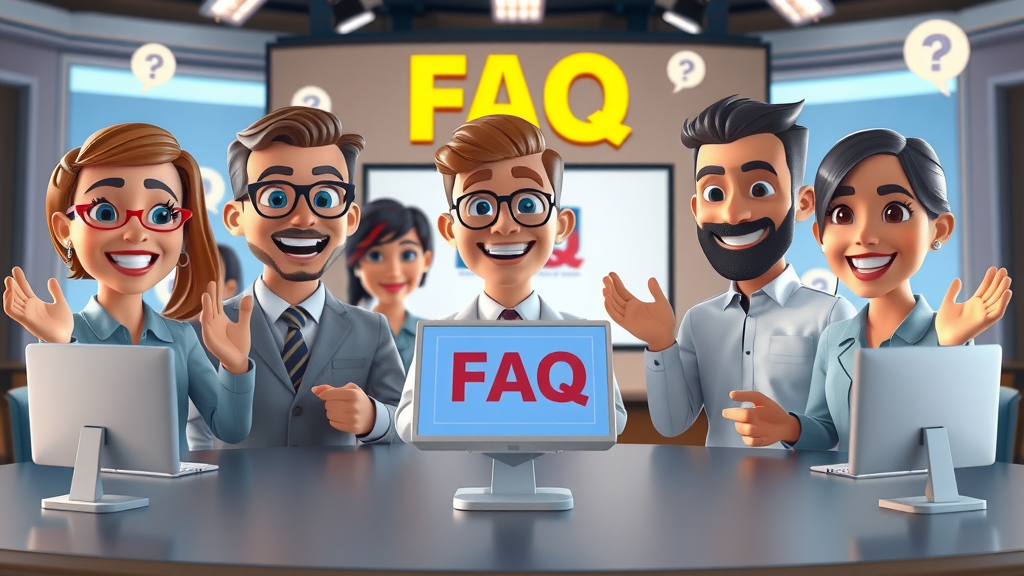Did you know that over 80% of online traffic is now driven by video content ? In today’s digital landscape, simply publishing blog content is not enough to set your brand apart. Audiences crave authentic expertise and connection—which is exactly where video content marketing & blogging work hand in hand. By integrating video into your marketing strategy, you not only establish yourself as a thought leader but also build durable trust with your target audience, creating new avenues for brand growth at every stage of the customer journey.
In this comprehensive guide, you'll learn why content marketing & blogging , paired with dynamic video, are the ultimate tools for branding, authority, and engagement.
Unlocking the Power of Video in Content Marketing & Blogging
Video content is no longer a luxury—it's a necessity in the world of content marketing & blogging . According to recent industry reports, businesses that incorporate video into their marketing strategy see 49% faster revenue growth than those that don’t. Videos engage, inform, and inspire your audience far beyond the capacity of traditional blog posts or even static images. They transform your blog content from static to interactive, providing practical solutions to critical pain points and making complex concepts accessible to every potential customer.
The use of videos as part of your content strategy has made it possible for brands—from small businesses to multinational enterprises—to showcase expertise and humanize their offerings. This not only resonates with your target audience, but also signals to search engines that you are delivering valuable content, pushing your digital presence ahead of competitors. In fact, content marketers who master the synergy between blogging and video set the foundation for high-impact marketing campaigns that position their brand as a thought leader.
-
Statistic: 72% of customers say they prefer learning about a service or product through video, highlighting the immense influence video marketing has on consumer decision-making.
-
By combining video content marketing & blogging, you can rapidly elevate your status and trust factor as an expert in your niche.

Why Content Marketing & Blogging Matter More Than Ever for Your Brand
Defining Content Marketing & Blogging in the Digital Age
In today's fast-paced digital environment, content marketing & blogging are central to any successful marketing plan. Content marketing refers to the strategic creation and distribution of high-value information—using blogs, videos, social media posts, and even paid ads—to attract, educate, and retain potential customers. Blogging, as a subset, specifically involves producing regular articles (or blog posts) on your website to showcase expertise, share insights, and connect with your target audience.
Modern content marketers leverage diverse formats to stay competitive. A well-executed content marketing strategy goes beyond just churning out blog posts—it’s about understanding the pain points of your buyer persona and delivering highly relevant, valuable content at every stage of the customer journey. As search engines become more sophisticated, the role that varied types of content play in building visibility, authority, and trust has greatly intensified.
The Role of Content Marketers and Their Strategies Today
Content marketers today are just as much strategists as they are creators. They must design a unified content strategy that ties together blog posts, videos, social media, and marketing campaigns into a cohesive narrative. This involves aligning every piece of content to customer needs, driving both brand awareness and audience engagement.
The modern content marketer is focused on gaining trust, positioning themselves (and their brands) as industry thought leaders, and using data-driven tactics to continually refine their approach. They understand that high-performing blog content is only the starting point; incorporating various multimedia elements—especially video—can exponentially amplify reach, boost search engine rankings, and deepen user trust.
As you refine your approach to integrating video and blogging, it's essential to measure the effectiveness of your efforts. Leveraging marketing analytics to track ROI can help you identify which content formats and channels are driving the most engagement and conversions, ensuring your strategy remains data-driven and impactful.
How Marketing Strategy Evolves with Multimedia Content Formats
The evolution of a modern marketing strategy hinges on embracing new content formats and platforms. As digital marketing advances, businesses can no longer rely solely on written blog posts. Integrating video, infographics, podcasts, and interactive media ensures your brand stands out in a crowded space. Multimedia approaches address different learning preferences and increase the likelihood that your content will resonate with a wider range of potential customers.
Experimenting with multiple types of content not only keeps your brand fresh but also signals to search engines that your website is an active, authoritative resource. Content marketers constantly monitor these changes to optimize their content marketing strategy—staying ahead of trends and finding the best ways to connect with their target audience on the platforms they use most.
“What You’ll Learn” About Content Marketing & Blogging With Video
-
How video can elevate your blog content and social media marketing.
-
The key differences and synergies between content marketing and blogging.
-
Practical steps to incorporate video into your overall marketing strategy.
-
Metrics to assess trust, authority, and engagement.
-
Actionable ways to build thought leadership with effective content types.
The Foundations: Core Principles for Content Marketing & Blogging Success

Understanding Your Target Audience and Their Needs
The bedrock of a successful content marketing & blogging approach is a deep understanding of your target audience . Content marketers begin with thorough research to identify the demographics, motivations, and pain points of their ideal buyer persona. Whether your piece of content is a detailed guide, a thought-provoking video, or a blog post, it must resonate with the needs and aspirations of your audience.
By focusing on what truly matters to potential customers, you ensure your marketing strategy is built around value and relevance. Audience research also enables you to uncover content gaps, design personalized messaging, and address questions your competitors leave unanswered. This customer-centric mindset sets the stage for stronger connections, more effective lead generation, and increased loyalty over time.
Aligning Content Strategy with Brand Awareness and Thought Leadership
For content marketers, aligning your content strategy with the goals of brand awareness and thought leadership is crucial. Every blog post, video, and social media update should reinforce your expertise and perspective in the industry. This builds “top-of-mind” awareness, ensuring your brand becomes the go-to source when potential customers encounter challenges or questions.
Consistent messaging across channels not only amplifies your influence but also positions your company as a solution provider and thought leader. As you nurture this reputation, you cultivate a sense of authority and reliability—essentials for climbing search engine rankings and converting prospects into loyal followers.
Integrating Different Types of Content for a Well-Rounded Content Marketing Strategy
A well-rounded content marketing strategy requires a mix of content formats designed to reach every part of the funnel. Combine informative blog content, short-form explainer videos, interviews, and case studies to address each stage of the buyer’s decision-making process. Content marketers who embrace variety are equipped to engage audiences who prefer consuming information in different ways.
This integration of multiple types of content not only improves your chance of resonating with various segments but also ensures your presence on diverse platforms—be it your website, social media, or paid ad channels. The result is increased reach, enhanced engagement, and stronger brand loyalty.
Harnessing Video Content Marketing to Amplify Blogging Results
Video as a Powerful Tool for Content Marketers
Video is rapidly emerging as the most effective tool in the content marketer’s arsenal. When embedded within blog content or shared across social media marketing channels, video offers an emotional punch, delivering your message quickly and memorably. Its visual and auditory elements create a lasting impression that static words struggle to achieve.

As part of your marketing strategy, use video to demonstrate industry knowledge, answer frequently asked questions, and provide solutions to your audience’s pain points. These efforts build trust, enhance search engine visibility, and substantially increase the time users spend engaging with your content. Video can also drive shares and backlinks, multiplying the business impact of each blog post or campaign.
Blog Post and Blog Content Enhancement Through Strategic Video
Thoughtfully integrating videos into your blog content can transform a static blog post into an interactive multimedia experience. For example, a written tutorial can be accompanied by a step-by-step explainer video, or a case study can include interviews with satisfied customers. This synergy bolsters understanding and drives better outcomes at every stage of your marketing plan.
Blog posts featuring relevant videos routinely achieve higher rankings in search engines, demonstrate greater authority, and foster trust with potential customers. By bridging written content with visual storytelling, you give your audience multiple ways to access and absorb your expertise, improving engagement metrics and maximizing overall impact.
Case Studies: Marketing Plan Success Stories Using Video in Content Marketing
Brands across industries have achieved outstanding results by weaving video into their content marketing strategy. For instance, SaaS companies often use demo and testimonial videos to address specific pain points and illustrate real-world value, while retail brands create behind-the-scenes footage to boost transparency and conversion rates. According to industry case studies , such tactics resulted in a 66% increase in qualified leads for brands in 2023.
“Video marketing increased qualified leads for brands by 66% in 2023, according to industry data.”
These success stories highlight the pivotal role that authentic, actionable video plays in any modern marketing campaign.
Optimizing Your Content Marketing Strategy with Video and Blogging
Choosing the Right Content Format for Your Marketing Efforts
Selecting the best content format is fundamental to maximizing the effectiveness of your marketing efforts. Content marketers analyze audience preferences, buyer persona insights, and performance data to decide whether an idea should become a video, a blog post, or a paid ad. For educational topics, explainer videos may outperform written guides, while ongoing industry updates might be better served via blog content.

The key is to match content format to the habits and needs of your target audience. A strategic balance between videos, blog content, social media posts, and paid ads ensures that every marketing campaign delivers value at the right point in the customer journey, increasing the odds of conversion and sustained engagement.
Fostering Engagement via Social Media and Digital Marketing
Social media is the engine that drives modern content marketing. Videos are especially powerful here—they’re shared 1200% more than links and text combined on major platforms. Content marketers should harness social media to amplify their blog content, spark meaningful conversations, and generate buzz around their brand through digital marketing best practices.
The interplay between blogging, video, and interactive media marketing is essential for staying top-of-mind. Cross-promotion, user-generated content, and influencer partnerships can all help foster deeper genuine engagement, widen reach, and generate valuable community feedback for future marketing efforts.
Paid Ads, Social Media Marketing, and the Value of Consistency
Integrating paid ad strategies with organic blog content and social media boosts both reach and reliability. Regular publishing builds anticipation and trust with your audience while ensuring search engines recognize your brand as a reliable authority. Whether promoting your top-performing video or a new blog post, a consistent posting schedule forms the backbone of any effective content marketing strategy .
Savvy content marketers use analytics to monitor the performance of each content type, refining their schedule and approach to optimize results across every channel. This ensures every marketing effort—paid or organic—drives the business outcomes that matter most.
|
Content Type |
Channel |
Target Outcome |
Metrics to Track |
|---|---|---|---|
|
Video |
Social Media |
Brand Awareness |
Views, Shares |
|
Blog Post |
Website |
Organic Traffic |
Time on Page, Comments |
|
Paid Ad |
Facebook/YouTube |
Conversions |
CTR, Conversions |
Becoming a Thought Leader: Building Authority with Content Marketing & Blogging
Examples of Thought Leaders Leveraging Video and Blog Content
Today’s industry thought leaders masterfully blend blog content, video, and social media to establish authority. Influential marketers like Neil Patel and brands such as HubSpot deploy in-depth video series alongside comprehensive blog posts to educate and empower their audiences. These combined efforts demonstrate mastery of subject matter, foster trust, and position brands as reliable resources in their fields.

The secret behind these successes lies in authenticity and actionable advice. By offering behind-the-scenes glimpses, how-to guides, and expert interviews in both written and video formats, these thought leaders break down barriers and connect on a deeper level with their audiences.
How Diverse Types of Content Boost Trust and Brand Loyalty
Mixing different types of content—insightful blog content, educational video series, and real-life case studies—leads to richer engagement and stronger relationships. Video tutorials build credibility, while behind-the-scenes blog content adds a human touch, helping your audience relate on a personal level. Repurposing videos into blog posts (and vice versa) extends your reach and reinforces your core messages across platforms.
This multipronged approach is critical for building brand awareness, trust, and lasting loyalty in competitive markets. Whether you’re a solo content marketer or part of a larger team, diversifying your content types gives your brand multiple avenues to demonstrate authority and reinforce your distinct thought leadership.
-
Establish credibility with educational video series
-
Use behind-the-scenes blog content to humanize your brand
-
Repurpose video content into blog posts and vice versa
Best Practices: Crafting Content Marketing Strategies that Include Video and Blogging
Developing an Integrated Content Marketing Strategy

Successful content marketing strategies don’t treat video and blogging as separate silos. Instead, content marketers build integrated plans that connect these formats across marketing channels, ensuring a consistent brand narrative. Start with a clear understanding of your target audience, clarify your messaging pillars, and map out a content calendar where blog content and video reinforce each other.
Use workflows that encourage collaborative ideas, allowing your team to leverage multiple perspectives on key content topics. This approach not only streamlines the creation process but also boosts the diversity and effectiveness of each piece of content you publish.
Ensuring Cohesion Across Blog Posts, Social Media, and Marketing Channels
Cohesion is achieved by aligning design, messaging, and publication schedules across all channels. For example, when launching a new product, coordinate your video teaser, blog announcement, and social media campaign for maximum impact. Tools like editorial calendars and brand guidelines help keep messaging consistent, strengthening both trust and brand awareness throughout the buyer’s journey.
Whether you’re planning a major event or a weekly update, weaving together blog posts, video content, and digital campaigns ensures your brand delivers a seamless and memorable audience experience.
Tracking Performance and Refining Your Approach with Analytics
Analytics are the linchpin of a high-performing content marketing strategy. Content marketers should track key performance metrics—such as time on page, video watch rate, social shares, and paid ad conversions—to understand what resonates with their audience. Use this information to refine your marketing efforts, doubling down on the content types and topics that drive the strongest engagement and ROI.
Regular performance reviews enable your team to course-correct, experiment with new ideas, and capitalize on shifting market trends—ensuring continuous improvement across all your marketing channels.
“Consistency across content types is the backbone of any effective content marketing strategy.”
Overcoming Challenges in Video Content Marketing & Blogging

Addressing Time, Budget, and Resource Constraints
Many small businesses and startups believe that video content marketing is out of reach due to limited resources. However, creative planning and embracing DIY video techniques can deliver impressive results. From smartphone footage to low-cost editing tools, content marketers can still match the authenticity and relevance their target audience craves.
Prioritize key content types for video based on audience demand and marketing plan priorities, ensuring maximum ROI for each minute and dollar spent. Over time, reinvesting early wins into upgraded equipment and professional editing can amplify your brand even further.
Bridging the Gap Between Creative Vision and Marketing Plan Execution
A common pain point in content strategy is translating creative ideas into real-world content that drives engagement. Content marketers should build workflows that balance creative freedom with practical budgets, timelines, and technical skills. Collaborative brainstorming, clear storyboards, and sound project management tools can help keep all marketing efforts on track.
Having a documented content marketing strategy also facilitates smooth execution—ensuring every piece of content, from blog post to paid ad, works in harmony toward the same business goals.
Staying Ahead of Evolving Content Strategy Trends
With search engines, platforms, and audience behaviors changing rapidly, it’s vital to stay informed of the latest trends in video content marketing & blogging. Subscribe to industry blogs, participate in webinars, and frequently survey your audience to surface emerging preferences and potential pain points.
Tips and tools demo: How to create engaging video content for your blog and marketing efforts even as a small team.
People Also Ask: Key Questions on Content Marketing & Blogging

What is a content marketing blog?
-
A content marketing blog is an online platform where content marketers publish tailored articles, videos, and multimedia to enhance a brand's marketing strategy, build authority in their industry, and engage target audiences.
What is the difference between content marketing and blogging?
-
Content marketing encompasses a strategic approach to creating and distributing diverse types of content—including blog posts, video, social media, and paid ads—while blogging refers specifically to articles published on a website.
What are the 3 C’s of content marketing?
-
The 3 C's are: Content (relevant, high-quality information), Context (targeted delivery to the right audience), and Consistency (publishing regularly to build trust and authority).
What is the 70 20 10 rule in content marketing?
-
The 70 20 10 rule guides content creation: 70% is basic or core content (blog posts, educational videos), 20% is curated or repurposed from other sources, and 10% is experimental and innovative to test new approaches.
Frequently Asked Questions on Content Marketing & Blogging

-
How does video improve blog engagement metrics?
Video engages audiences longer, increases time spent on pages, and boosts social shares—contributing to both SEO and user retention for any blog post. -
Which social media channels are best for video content marketing?
Leading platforms include YouTube, Facebook, Instagram, and LinkedIn, each offering rich capabilities for distributing and promoting video content to your target audience. -
How to measure the ROI of video blog content?
Track metrics such as video views, engagement rates, click-through rates, conversions, and eventual revenue impact to assess the ROI of your video-enhanced blog content. -
What are the most effective blog content formats for lead generation?
In-depth guides, how-to videos, case studies, and gated content such as downloadable resources paired with strong calls-to-action generate high-quality leads.
Actionable Tips for Content Marketers: Next Steps for Effective Blogging and Video Integration
-
Audit your current blog content and identify video integration opportunities.
-
Develop a cross-channel marketing strategy aligning video, social media, blog, and paid ads.
-
Measure performance and iterate with analytics and audience feedback.
“When brands leverage both video and blogging, they create multifaceted engagement and lasting trust with their audiences.”
Key Takeaways: Elevate Your Content Marketing & Blogging With Video
-
Video content builds authority, trust, and expertise faster than written content alone
-
Successful content marketing strategies integrate videos with blogs and social media
-
Regularly assessing results ensures your marketing plan stays effective
Start Elevating Your Brand: Embrace Content Marketing & Blogging with Video

-
Take your content marketing & blogging strategies to the next level by integrating video and amplifying your brand's reach and trust. Become the thought leader your target audience is searching for today.
If you’re ready to expand your marketing impact even further, consider how your video and blogging efforts can be amplified through coordinated social media and email campaigns. Exploring advanced strategies for social media and email marketing integration will help you reach audiences where they’re most active, nurture leads, and drive consistent engagement across channels. By weaving together these powerful tactics, you’ll unlock new opportunities for brand growth and customer loyalty. Dive deeper into the possibilities and discover how a holistic approach can elevate every aspect of your content marketing journey.
To deepen your understanding of content marketing and blogging, consider exploring the following resources:
-
“Blogging vs. Content Marketing: Differences and Benefits” ( wix.com )
This article clarifies the distinctions between blogging and content marketing, highlighting how each serves unique roles within a comprehensive digital strategy.
-
“7 Tips for Making Your Blog a Content Marketing Magnet” ( socialmediaexaminer.com )
This piece offers actionable strategies to enhance your blog’s effectiveness in attracting and engaging your target audience.
By delving into these resources, you’ll gain valuable insights to refine your content marketing and blogging approaches, ensuring they work synergistically to achieve your business objectives.
 Add Row
Add Row  Add
Add 


Write A Comment